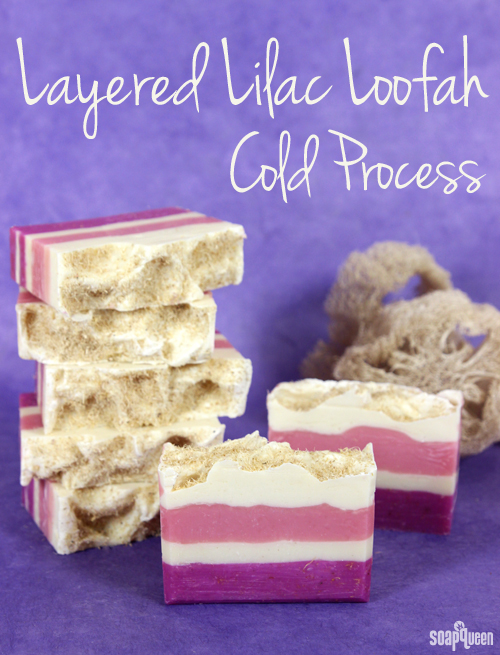
What You’ll Need:
10″ Silicone Loaf Mold
3.6 oz. Avocado Oil
1.8 oz. Castor Oil
7.2 oz. Cocoa Butter
9 oz. Coconut Oil
3.6 oz. Green Tea Seed Oil
1.8 oz. Mango Butter
7.2 oz. Olive Oil
1.8 oz. Shea Oil
5 oz. Sodium Hydroxide
11.9 Distilled Water
Radiant Plum Colorant
Titanium Dioxide Pigment
Ultramarine Lavender Pigment
Electric Bubblegum Colorant
2.5 oz. Lilac Fragrance Oil
1 tbs. Shredded Loofah

If you’ve never made Cold Process soap before, check out our FREE four part SoapQueen.tv series on Cold Process Soapmaking, especially the episode on lye safety. Bramble Berry also carries a wide range of books on the topic, including Soap Crafting. You can also checkout the digital downloads.
SAFETY FIRST: Suit up for safety! That includes goggles, gloves and long sleeves. Make sure kids, pets, and other distractions and tripping hazards are out of the house or don’t have access to your soaping space. Always soap in a well-ventilated area.
COLOR PREP: Add 1 teaspoon of each colorant into 1 tablespoon of a lightweight liquid oil, like sunflower or sweet almond oil. To get the clumps worked out, use a mini mixer.
ONE: Carefully and slowly add the lye to the water and stir until the lye is fully dissolved and the liquid is completely clear. Set the lye and water aside to cool.
TWO: Melt and combine the mango butter, cocoa butter, coconut, olive, shea, green tea seed, castor and avocado oils. Once the oils and lye water have cooled to 130 degrees or below (and ideally within 10 degrees of each other), add the lye water to the oils. Stick blend until you reach very thin trace. If you want a harder bar of soap that releases faster from the mold, add sodium lactate to your cooled lye water. Add 1 teaspoon of sodium lactate per pound of oils in the recipe. For this recipe, you would add about 2 tsp. sodium lactate to your lye water.
Note: Lilac Fragrance Oil causes the trace to accelerate, so make sure to stop stick blending once you have reached very thin trace.
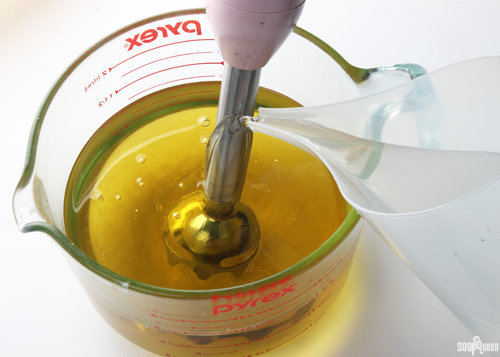
 TWO: When your soap is at a thin trace, pour about 1.5 cups of soap into two small containers. To one of the small containers, add 1 tbs. Radiant Plum Colorant and 1 tbs. shredded loofah. Use a whisk to fully incorporate the additives.
TWO: When your soap is at a thin trace, pour about 1.5 cups of soap into two small containers. To one of the small containers, add 1 tbs. Radiant Plum Colorant and 1 tbs. shredded loofah. Use a whisk to fully incorporate the additives.
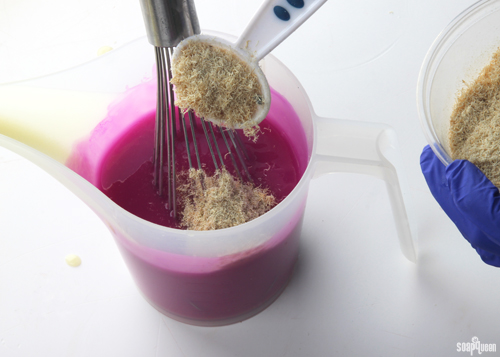 THREE: Add .75 ounces of Lilac Fragrance Oil to the container. Mix well using a whisk.
THREE: Add .75 ounces of Lilac Fragrance Oil to the container. Mix well using a whisk.
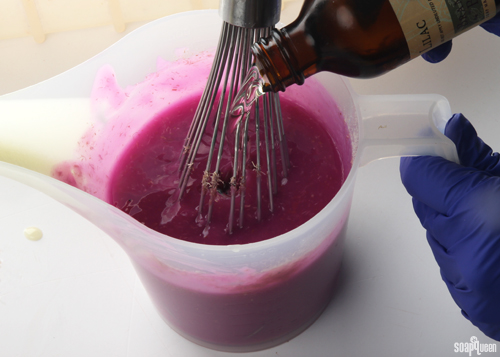 FOUR: Carefully pour the purple colored soap into the mold. Then, tap the mold down firmly on the counter to evenly disperse the soap and release any air bubbles. You will notice how quickly the soap starts to thicken.
FOUR: Carefully pour the purple colored soap into the mold. Then, tap the mold down firmly on the counter to evenly disperse the soap and release any air bubbles. You will notice how quickly the soap starts to thicken.
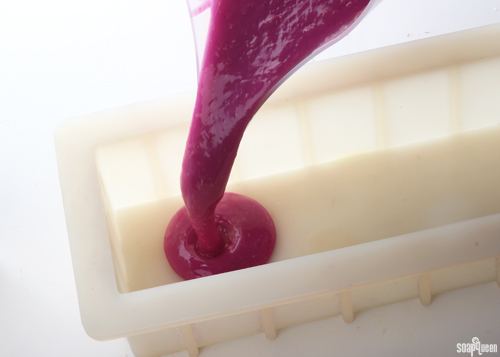 FIVE: Add 1 Tbsp. of titanium dioxide and 1 oz. of Lilac Fragrance Oil to the large container of soap. Use a whisk to mix well.
FIVE: Add 1 Tbsp. of titanium dioxide and 1 oz. of Lilac Fragrance Oil to the large container of soap. Use a whisk to mix well.
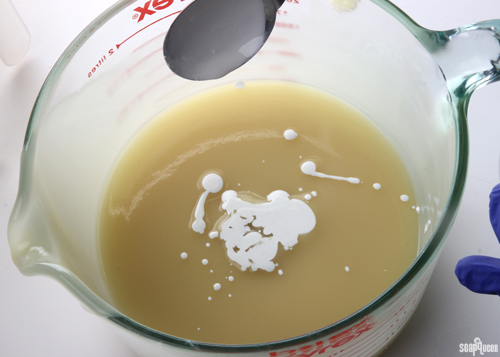 SIX: Pour about half of the white soap on top of the purple layer. To prevent the soap from breaking through the purple layer, pour the soap over a spatula into the mold. Then, use the spatula to evenly spread the white soap out and tap the mold firmly on the counter.
SIX: Pour about half of the white soap on top of the purple layer. To prevent the soap from breaking through the purple layer, pour the soap over a spatula into the mold. Then, use the spatula to evenly spread the white soap out and tap the mold firmly on the counter.
 SEVEN: To the other small container, add 1/2 tsp. of Electric Bubblegum Colorant and 1 tsp. of Ultramarine Lavender Pigment. Then, add .75 ounces of Lilac Fragrance Oil and mix well with a whisk.
SEVEN: To the other small container, add 1/2 tsp. of Electric Bubblegum Colorant and 1 tsp. of Ultramarine Lavender Pigment. Then, add .75 ounces of Lilac Fragrance Oil and mix well with a whisk.
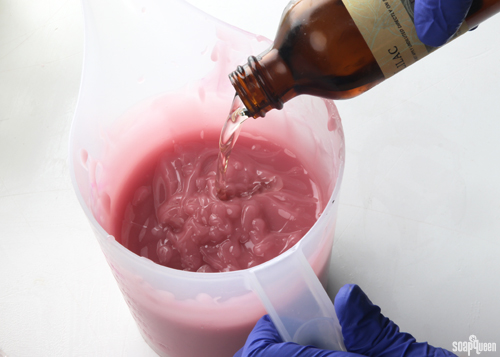 EIGHT: Pour the pink soap carefully into the mold. The soap will be very thick. You can pour the soap over a spatula to prevent it from breaking through the white layer. Use that same spatula to evenly spread the soap. Tap the mold on the counter to release any possible bubbles.
EIGHT: Pour the pink soap carefully into the mold. The soap will be very thick. You can pour the soap over a spatula to prevent it from breaking through the white layer. Use that same spatula to evenly spread the soap. Tap the mold on the counter to release any possible bubbles.
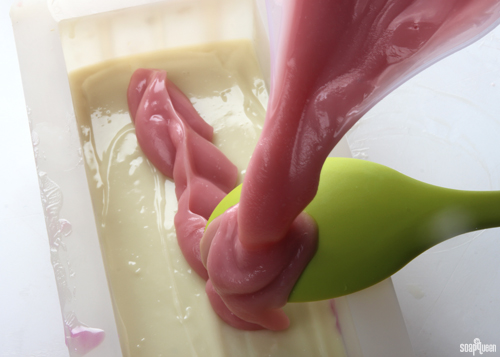 NINE: Carefully pour the last of the white soap into the mold. We found the pink soap was firm enough we didn’t have to pour over a spatula. Using a spoon, create a textured top. You can do any design you like!
NINE: Carefully pour the last of the white soap into the mold. We found the pink soap was firm enough we didn’t have to pour over a spatula. Using a spoon, create a textured top. You can do any design you like!
 TEN: When you are happy with the textured top, sprinkle shredded loofah evenly over the top of the soap.
TEN: When you are happy with the textured top, sprinkle shredded loofah evenly over the top of the soap.
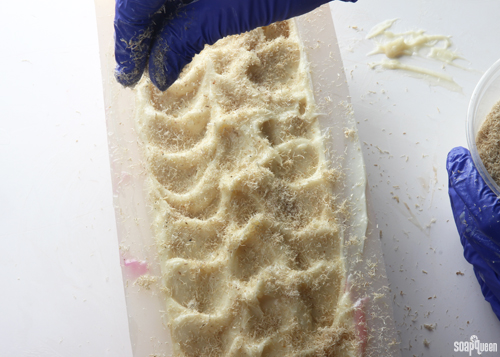 Spritz with isopropyl alcohol to prevent soda ash and place a piece of cardboard and a blanket or towel over the mold. Put the soap on a heating pad for about 15-20 minutes. Remove from the heating pad and let the soap sit overnight. Cure for 4-6 weeks and enjoy!
Spritz with isopropyl alcohol to prevent soda ash and place a piece of cardboard and a blanket or towel over the mold. Put the soap on a heating pad for about 15-20 minutes. Remove from the heating pad and let the soap sit overnight. Cure for 4-6 weeks and enjoy!

